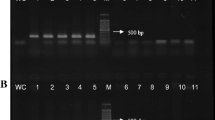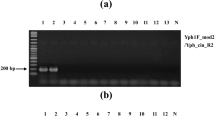Abstract
A polymerase chain reaction (PCR)-based test for potato late blight (Phytophthora infestans) and pink rot (P.erythroseptica, P. nicotianae) diseases has been developed for use with potato tuber tissue. Primers based on sequence analysis of the ITS2 region of ribosomal DNA of late blight and pink rot pathogens were utilized in PCR assays of inoculated tubers and tubers harvested from plots known to have late blight and/or pink rot. Assays of artificially inoculated Kennebec and Russet Burbank tubers revealed thatP. infestans was detected by PCR as early as 72 h after inoculation and in the absence of visible symptoms. Much higher detection frequencies were obtained by PCR compared with plating on selective medium or placement of tissue in moist chambers. Tubers from plots known to have late blight and/or pink rot were tested using the PCR assay. Assay of late blight lesions showed ca. 80% recovery for late blight-infected tubers from the field. Results indicate that the PCR assay provides a rapid and accurate test for diagnosis of late blight and pink rot in potato tubers.
Similar content being viewed by others
Literature Cited
Carter, D.A., S.A. Archer, K.W. Buck, D.S. Shaw, and R.C. Shattock. 1990. Restriction fragment length polymorphisms of mitochondrial DNA ofPhytophthora infestans. Mycol Res 94:1123–1128.
Caten, C.E., and J.L. Jinks. 1968. Spontaneous variability of single isolates ofPhytophthora infestans. I. Cultural variation. Can J Bot 46:329–348.
Ehrlich, H.A., D. Gelfand, and J.J. Sninsky. 1991. Recent advances in the polymerase chain reaction. Science 252:1643–1651.
Fry, W.E., S.B. Goodwin, A.T. Dyer, J.M. Matuszak, A. Drenth, P.W. Too-ley, L.S. Sujkowski, Y.J. Koh, B.A. Cohen, L.J. Spielman, K.L. Deahl, D.A. Inglis, and KP. Sandian. 1993. Historical and recent migrations ofPhytophthora infestans: chronology, pathways, and implications. Plant Dis 77:653–661.
Goodwin, P.H., B.C. Kirkpatrick, and J.M. Duniway. 1989. Cloned DNA probes for identification ofPhytophthora parasitica. Phytopathology 79:716–721.
Goodwin, S.B., A. Drenth, and W.E. Fry. 1992. Cloning and genetic analysis of two highly polymorphic, moderately repetitive nuclear DNAs fromPhytophthora infestans. Curr Genet 22:107–115.
Goodwin, S.B., L.S. Sujkowski, A.T. Dyer, B.A. Fry, and W.E. Fry. 1995. Direct detection of gene flow and probable sexual recombinationat Phytophthora infestans in northern North America. Phytopathology 85:473–479.
Hadidi, A., L. Levy, and E.V. Podleckis. 1995. Polymerase chain reaction technology in plant pathology. Pages 167–187In: Molecular Methods in Plant Pathology (R.P. Singh and U.S. Singh, eds.). CRC Press Inc., Boca Raton, FL.
Henson, J.M and R. French. 1993. The polymerase chain reaction and plant disease diagnosis. Annu Rev Phytopathol 31:81–109.
Johnson, C.A. 1996. NPC passes resolution seeking changes in late blight inspection. Valley Potato Grower, March 1996:16.
Lee, S.B., T.J. White, and J.W. Taylor. 1993. Detection of Phytophthora species by oligonucleotide hybridization to amplified DNA spacers. Phytopathology 83:177–181.
Saiki, R.K., D.H. Gelfand, S. Stoffel, S.J. Scharf, R. Higuchi, G.T. Horn, KB. Mullis, and H.A. Ehrlich. 1988. Primer-directed enzymatic amplification of DNA with a thermostable DNA polymerase. Science 239:487–491.
SAS Institute Inc. 1987. SAS/STAT Guide for Personal Computers, Version 6 Edition. SAS Institute Inc., Cary, NC.
Spielman, L.J., A. Drenth, L.C. Davidse, L.J. Sujkowski, W.K. Gu, P.W. Tooley, and W.E. Fry. 1991. A second world-wide migration and population displacementof Phytophthora infestans? Plant Pathol 40:422–430.
Tooley, P.W. 1997. New technology tests tubers for blight. Spudman: April 1997:48–58.
Tooley, P.W., W.E. Fry, and M.J. Villarreal Gonzalez. 1985. Isozyme characterization of sexual and asexualPhytophthora infestans populations. J. Hered. 76:431–435.
Tooley, P.W., B.A. Bunyard, M.M. Carras, and E. Hatziloukas. 1997. Development of PCR primers from the ITS2 region for detection ofPhytophthora species infecting potatoes. Appl Environ.Microbiol 63:1467–1475.
Wang, H., M. Qi, and A.J. Cutler. 1993. A simple method of preparing plant samples for PCR. Nucl Acids Res 21:4153–4154.
Author information
Authors and Affiliations
Rights and permissions
About this article
Cite this article
Tooley, P.W., Carras, M.M. & Lambert, D.H. Application of a PCR-based test for detection of potato late blight and pink rot in tubers. Am. J. Pot Res 75, 187–194 (1998). https://doi.org/10.1007/BF02853572
Accepted:
Issue Date:
DOI: https://doi.org/10.1007/BF02853572




